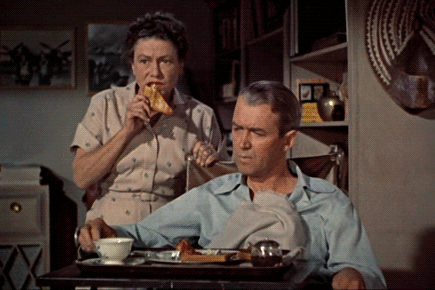The first time I saw Rear Window, I was in high school, still living with my mother out in the suburb of a small town. We had neighbours, but each ensconced in their own acre-sized lot, with no windows that could be seen from my windows except in the vaguest way possible. I didn’t even know anyone who lived in an apartment.
It’s a sweltering New York summer, and Jeff (James Stewart), a photographer, is cooped up in his West Village apartment, his broken leg in a cast. He spends his days gazing out his window at the apartment building opposite him, and thanks to the heat wave,  everyone’s got their windows open and their business on display. It’s a lesson in voyeurism that probably also comments upon the movie going experience, our own gaze from within a darkened theatre into the secret lives of others. “We’ve become a nation of peeping toms,” complains Stella (Thelma Ritter), Jeff’s nurse, and she’s not wrong. But immobilized in a wheel chair, Jeff is spellbound by the people across the courtyard, and becomes convinced that one of them has committed murder. Soon the skeptical nurse gets pulled into his nonsense as well, as does Stewart’s love interest Lisa, played by Grace Kelly.
everyone’s got their windows open and their business on display. It’s a lesson in voyeurism that probably also comments upon the movie going experience, our own gaze from within a darkened theatre into the secret lives of others. “We’ve become a nation of peeping toms,” complains Stella (Thelma Ritter), Jeff’s nurse, and she’s not wrong. But immobilized in a wheel chair, Jeff is spellbound by the people across the courtyard, and becomes convinced that one of them has committed murder. Soon the skeptical nurse gets pulled into his nonsense as well, as does Stewart’s love interest Lisa, played by Grace Kelly.
Now, of course Jeff is watching his neighbours with murder on his mind, but it’s impossible not to note that there’s another big M being observed: marriage. Remember that Lisa, kind, wonderful, thoughtful, beautiful Lisa, is doing most of the pursuing in her relationship with Jeff, and he’s doing most of the resisting. Marriage, to him, is a bigger trap than the cast he’s saddled with on his leg. The other apartment building has all sorts of marriage on display from newlyweds pulling down their blind for “alone time” to the old married couple always bickering. And perhaps the couple so fed up with each other they may resort to murder.
Incredibly, the entire set was built on a Paramount sound studio over two months, the set measuring 98 feet wide, 185 long and 40 high. The courtyard is about 20 to 30 feet below stage level, so they actually tore up the stage and built the courtyard in the basement, which used to be a storage area. That way when you look down from Jeff’s apartment,  the perspective is just right. The set’s buildings consisted of 31 apartments wired for electricity and plumbed for water; a dozen of them were completely furnished. Georgine Darcy, who played Miss Toros (the dancer), lived in the apartment all day long, resting there between takes as if it were really her home. There were 1000 large lights and 1000 smaller ones to simulate sunlight; once it got so hot on set that it set off the sprinklers. Hitchcock directed the whole thing from Jeff’s apartment. The actors in the building across the courtyard wore flesh-coloured ear pieces and took direction that way.
the perspective is just right. The set’s buildings consisted of 31 apartments wired for electricity and plumbed for water; a dozen of them were completely furnished. Georgine Darcy, who played Miss Toros (the dancer), lived in the apartment all day long, resting there between takes as if it were really her home. There were 1000 large lights and 1000 smaller ones to simulate sunlight; once it got so hot on set that it set off the sprinklers. Hitchcock directed the whole thing from Jeff’s apartment. The actors in the building across the courtyard wore flesh-coloured ear pieces and took direction that way.
Rear Window is one of my favourite Hitchcock films. When Sean and I rewatched it recently we delighted in one-upping each other with our running commentary about James Stewart relationships with women in this movie. They’re worse than just dated. But the truth is, the film has held up well and is just as entertaining now as ever. It’s definitely One To Watch.



 to be financing thousands of ingenues, and Hollywood is crawling with unemployed actresses. Esther is nearly down to her last dollar when she meets Norman Maine, a famous film star who eyes her both romantically and professionally. But as they fall in love and he helps her with her career, his own takes hit after hit. An unreliable alcoholic, Norman seems to have used up all the public’s good will.
to be financing thousands of ingenues, and Hollywood is crawling with unemployed actresses. Esther is nearly down to her last dollar when she meets Norman Maine, a famous film star who eyes her both romantically and professionally. But as they fall in love and he helps her with her career, his own takes hit after hit. An unreliable alcoholic, Norman seems to have used up all the public’s good will.